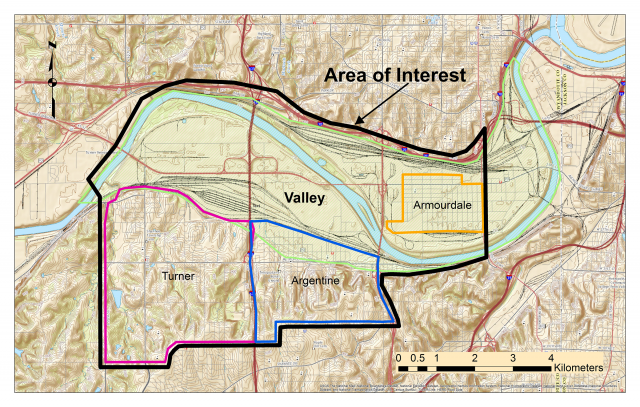Kansas City Transportation and Local-Scale Air Quality Study
In fall 2017, the EPA launched the Kansas City Transportation and Local-Scale Air Quality Study (KC-TRAQS), to learn more about local community air quality in three neighborhoods in Kansas City, Kansas, that have multiple air pollution sources from highways, railways, and industry. The study provided comprehensive air quality monitoring using three different air measurement approaches. A participatory science project was part of the study and involved area residents and students in air measurement activities.
The principal air pollutants of interest were fine particle pollution, known as PM2.5, and black carbon, a component of PM2.5. Fine particle pollution is the result of the combustion of fossil fuels used in passenger motor vehicles, truck engines, train engines, industry, and forest fires. Exposure to fine particles can affect both the lungs and heart.
The study area included the neighborhoods of Turner, Argentine and Armourdale in southeast Wyandotte County, Kansas. This area is in the Kansas river valley and has unique meteorological conditions that include inversions, which can trap pollutants close to the ground. The area is also surrounded by major highways and other roads, industry with diesel truck traffic, and two railyards, which include a rail maintenance facility and main rail track line.

Study Objectives
The study enabled EPA to provide air quality information to the community and its residents and advance air monitoring technology for use by other states and communities. The research was designed to measure and monitor air quality and was not a health study to evaluate health effects from any observed air pollution.
Monitoring Approach
There were three monitoring and measurement approaches used for the study that involved deployment of stationary, mobile, and portable measurement technologies. Researchers used regulatory grade methods and new and cutting-edge instruments to measure the air pollutants, black carbon (BC) fine particles (PM2.5) and nitrogen dioxide (NO2), as well as environmental conditions important to understanding air quality, including relative humidity, wind speed and wind direction, and temperature. The measurement instruments included:
- Stationary Monitors. Stationary or fixed monitors collected PM2.5, BC, and meteorological data in six locations within the study area.
- Mobile Monitors. An electric vehicle retrofitted with air quality monitoring instruments was used to drive designated routes through the study area to collect data. The mobile monitoring provided high-time resolution (1-second) measurements of particle number concentration, BC, and NO2, and allowed for increased coverage across the study area.
- AirMappers. A participatory science project was part of the study and enabled residents to use portable air monitors called AirMappers, developed by EPA, to collect air quality data. These lunch pail-size air monitors could be carried around the study area by local residents and students. The AirMapper included rechargeable battery power, a global positioning system (GPS), an optical particle sensor estimating PM2.5 and other PM size fractions, a carbon dioxide (CO2) sensor, and a noise sensor.
Results
EPA joined representatives of the Argentine, Armourdale, and Turner communities on Nov. 20, 2019 , to celebrate the completion of the air monitoring research project in Kansas City, Kansas. The project found that air quality in the neighborhoods was well within EPA’s national ambient air quality standards (NAAQS). EPA staff and community members worked closely together to make the project a success.
Contacts
Public Outreach: Steven Brown, Physical Scientist, brown.steven@epa.gov
Regional and Technical Lead: Stephen Krabbe, Physical Scientist, krabbe.stephen@epa.gov
Principle Investigator: Rachelle Duvall, Environmental Engineer, duvall.rachelle@epa.gov
Publications and Newsletters
- The Kansas City Transportation and Local-Scale Air Quality Study (KC-TRAQS): Integration of Low-Cost Sensors and Reference Grade Monitoring in a Complex Metropolitan Area. Part 1: Overview of the Project (Journal Article)
- Identifying Air Pollution Source Impacts in Urban Communities Using Mobile Monitoring (Journal Article)
- Kansas City Transportation and Local-Scale Air Quality Study (KC-TRAQS) - Summary of Project and Preliminary Results (Presentation)
- AirMapper Design, Operation, and Maintenance (Report)
- DIY Air Sensor Now Available for Use by Educators and Citizen Scientists (Science Matters Newsletter)
